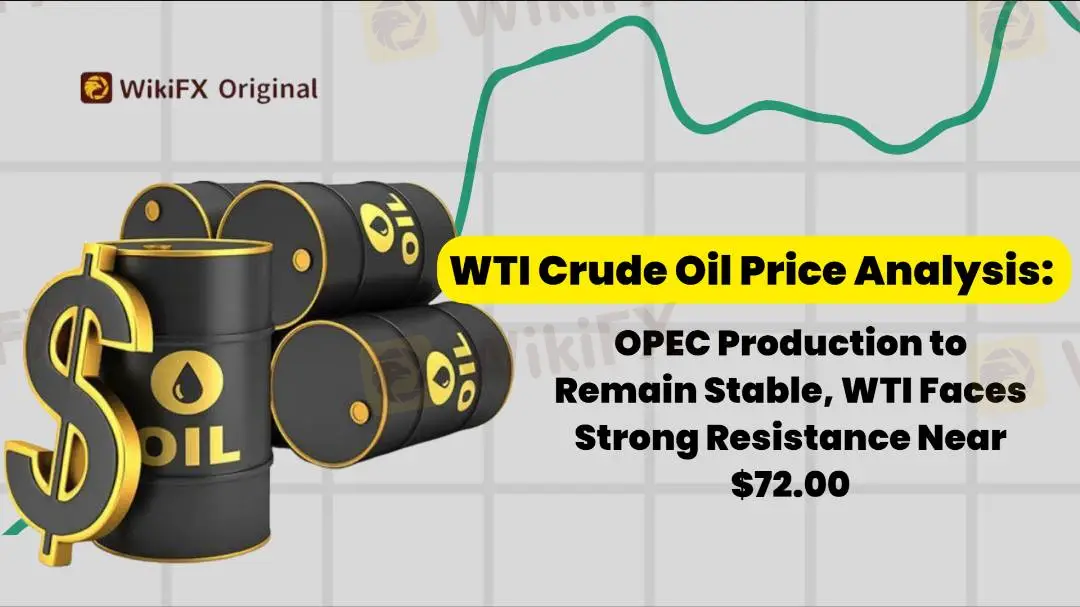简体中文
繁體中文
English
Pусский
日本語
ภาษาไทย
Tiếng Việt
Bahasa Indonesia
Español
हिन्दी
Filippiiniläinen
Français
Deutsch
Português
Türkçe
한국어
العربية
WTI Crude Oil Price Analysis
Abstract:The oil market experiences selling pressure as prices reach around $72.00 due to market expectations of no early OPEC production cuts. US debt ceiling negotiations remain at a standstill, while oil prices hover near a significant level since the uptrend line started from the low point of $67.47 on May 4th.

In early Asian trading, New York Mercantile Exchange's West Texas Intermediate (WTI) crude oil futures attempted to rebound towards the $72.00 level but faced strong resistance. Oil prices are expected to further recover downwards as OPEC is not anticipated to further cut crude production at the next meeting on June 4th.
Russian Deputy Prime Minister Alexander Novak stated that OPEC+ is not expected to take new measures at the June 4th meeting. In contrast, Saudi Arabia's Energy Minister, Abdulaziz bin Salman, hinted at the possibility of a new round of production cuts during the meeting.
The US Dollar Index (DXY) has consolidated around 104.21 as ongoing negotiations between the White House and Republican leaders indicate a continued deadlock before the US debt approaches default.
The 4-hour chart shows that oil prices failed to break above the 50% Fibonacci retracement level of the downward trend from the high of $83.40 on April 12th to the low of $64.31 on May 3rd, which was at $73.94. Selling pressure quickly emerged, pushing oil prices down. Additionally, the 200-period moving average at $73.72 acted as resistance.
Oil prices are at a crucial level near the uptrend line since the low of $67.47 on May 4th.
A decline in the Relative Strength Index (14) to the bearish range of 20.00-40.00 will trigger a downward momentum.
Looking ahead, if WTI crude oil prices fall below the low of $71.03 on May 25th, it will exert significant downward pressure, with WTI prices potentially dropping to the key support level of $70.00, followed by the 23.6% Fibonacci retracement level at $68.88.
On the other hand, if WTI oil prices stabilize and rebound above the 50% Fibonacci retracement level of $73.94, it will boost prices towards the 61.8% Fibonacci retracement level at $76.16. Breaking above this level, oil prices will test the high of $77.86 on April 26th.
4-hour chart of WTI oil prices

WTI Oil Price
Overview
Latest Price Today: 71.93
Today's Change: +0.10
Today's Change %: +0.14
Opening Price Today: 71.83
Trends
20-day Moving Average: 72.13
50-day Moving Average: 74.51
100-day Moving Average: 76
200-day Moving Average: 79.71
Levels
Previous Day High: 74.36
Previous Day Low: 71.03
Last Week High: 73.55
Last Week Low: 69.39
Last Month High: 83.4
Last Month Low: 73.88
Daily Chart 38.2% Fibonacci Retracement Level: 72.3
Daily Chart 61.8% Fibonacci Retracement Level: 73.09
Daily Chart Pivot Support 1: 70.45
Daily Chart Pivot Support 2: 69.08
Daily Chart Pivot Support 3: 67.12
Daily Chart Pivot Resistance 1: 73.79
Daily Chart Pivot Resistance 2: 75.74
Daily Chart Pivot Resistance 3: 77.12
*The provided information is for reference purposes only and should not be considered as financial advice or investment recommendation.

Disclaimer:
The views in this article only represent the author's personal views, and do not constitute investment advice on this platform. This platform does not guarantee the accuracy, completeness and timeliness of the information in the article, and will not be liable for any loss caused by the use of or reliance on the information in the article.
Read more

The Ultimate Guide to Automated Forex Trading in 2025
Modern markets are revolutionized by automated trading systems, which now execute 70-85% of all transactions. These advanced automated trading software solutions, commonly called trading robots or Expert Advisors (EAs), leverage algorithmic precision for automatic trading across forex, stocks, and commodities 24/7. By removing emotional interference and executing trades in microseconds, auto forex trading platforms create fair opportunities for all market participants. For those new to automated trading for beginners, these systems provide disciplined, backtested strategies while significantly reducing manual effort.

Will natural disasters have an impact on the forex market?
The forex market is known for its rapid responses to global events, but the influence of natural disasters, such as earthquakes and typhoons, can be less straightforward. While headlines may scream about catastrophic damage and economic disruption, the long-term effects on currency values often depend on a blend of immediate shock and underlying economic fundamentals.

Philippines Deports 29 Indonesians Linked to Online Scam Syndicate in Manila
Online scam groups in the Philippines trick Filipinos into gambling and love scams, from Manila to Bacolod, causing trafficking and pain as police fight back.

Why does your mood hinder you from getting the maximum return from an investment?
Investment decisions are rarely made in a vacuum. Aside from the objective data and market trends, our emotions—and our overall mood—play a crucial role in shaping our financial outcomes. Whether you’re feeling overconfident after a win or anxious after a loss, these emotional states can skew your decision-making process, ultimately affecting your investment returns.
WikiFX Broker
Latest News
How Crypto Trading Transforms FX and CFD Brokerage Industry
UK would not hesitate to retaliate against US tariffs - No 10 sources
FCA Warns Against 10 Unlicensed or Clone Firms
CySEC Warns Against 14 Unlicensed Investment Websites
Top Currency Pairs to Watch for Profit This Week - March 31, 2025
Will natural disasters have an impact on the forex market?
Philippines Deports 29 Indonesians Linked to Online Scam Syndicate in Manila
Navigating the Intersection of Forex Markets, AI Technology, and Fintech
Exposed: Deceptive World of Fake Trading Gurus – Don’t Get Fooled!
AI-Powered Strategies to Improve Profits in Forex Trading
Currency Calculator







